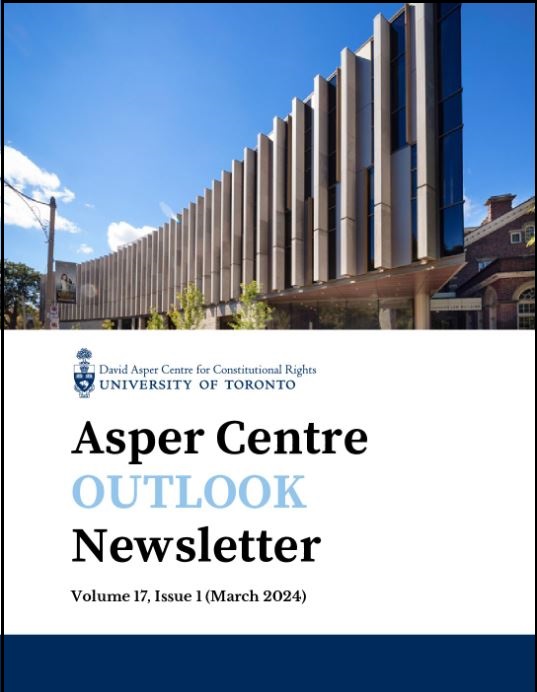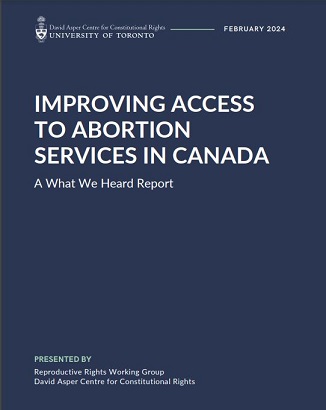by Katherine Shackleton and Sarah Zaitlin
On December 5th, 2023, Bill C-48 received royal assent in Parliament. Among other reforms to the Criminal Code, the bill expanded the reverse onus provision for offences involving intimate partner violence (IPV). The new reverse onus measures have sparked criticism from community members, advocacy groups, and academics.
Background
Section 11(e) of the Canadian Charter of Rights and Freedoms provides that “any person charged with an offence has the right not to be denied reasonable bail without just cause.” Generally, that means the onus is on the Crown to demonstrate why an accused person should be denied bail. The presumption is that bail should be granted unless the Crown can dislodge that presumption.
Reverse onus provisions in the Criminal Code flip the presumption for certain offences, making accused persons bear the onus of dislodging the presumption that bail should be denied. Bill C-48 expanded existing reverse onus provisions to include offences in which “violence was allegedly used, threatened, or attempted against their intimate partner, and the accused has been previously convicted or discharged under section 730 of an offence in the commission of which violence was used, threatened or attempted against any intimate partner” (Paragraph 515(6)(b.1)). This means that anyone accused of intimate partner violence with a prior conviction or discharge, meaning they may not have any criminal record, will be presumptively held without bail unless they can justify their release.
Legal Significance
Some scholars and community advocates are concerned that Bill C-48 will violate accused persons’ section 11(e) Charter rights.
The Supreme Court of Canada has interpreted section 11(e) as containing two components. In R v Pearson, Chief Justice Lamer identified these components as, firstly, the right to reasonable bail and, secondly, the right not to be denied bail without just cause.[1] For just cause to be present, Chief Justice Lamer set out two requirements. First, bail must be denied only in a narrow set of circumstances.[2] Secondly, the reason for denying bail must “promote the proper functioning of the bail system.”[3] Examples of objectives connected to the proper functioning of the bail system include public safety,[4] ensuring that the accused does not abscond,[5] and maintaining public confidence in the administration of justice.[6]
The constitutionality of reverse onus provisions has been considered by the SCC on two occasions. In Pearson, the Court upheld a reverse onus provision for accused individuals charged with trafficking and importation offences under the Narcotic Control Act.[7] While the provisions at issue facially denied the right to judicial interim release, the majority held that there was just cause for denying bail given the systematic nature of drug offences[8] and the higher risk that the accused could abscond before trial (based on American and Australian statistics).[9] Additionally, a reverse onus for accused individuals who were charged with another offence while on release for another indictable offence was upheld in Morales because it advanced public safety.[10]
Policy Concerns of Reverse Onuses
Reverse onuses raise a number of pressing policy concerns. First of all, by rendering pretrial detention more likely, expanded reverse onus provisions risk exacerbating the already dire situation in many detention facilities. Descriptions in court decisions of conditions inside Canadian detention facilities paint a grim picture and overcrowding has been identified as an important contributor to the problem.[11]
Additionally, pretrial detention is linked with false guilty pleas. Pretrial detention has a direct and powerful impact on the accused’s cost-benefit analysis.[12] When the onus is on the accused to justify their entitlement to bail, the cost of securing pretrial release is higher, both in terms of the time spent in detention and the cost of hiring a lawyer. Accordingly, reverse onus provisions may incentivize the accused to enter a false guilty plea, not because they are guilty, but to avoid further restriction of their liberty, financial strain, toll on mental and physical health, and the host of other problems which flow from incarceration. Of course, abysmal conditions in detention facilities will only increase the number of such false guilty pleas.
Moreover, the changes are likely to disproportionately impact marginalized community members, especially Black and Indigenous accused persons. In Canada, Black and Indigenous people are already overrepresented in detention.[13] The changes enacted through Bill C-48 are especially concerning because members of Black, Indigenous and other racialized communities are brought into custody for firearm offences at a higher rate than their average incarceration level.[14] Racial profiling and over-policing of Black communities are notable contributors to these elevated numbers.[15]
Reverse Onuses in the IPV Context
The relationship between reverse onuses and IPV is not as straightforward as it may initially seem. On one hand, supporters of reverse onus provisions in the IPV context argue that these provisions can protect victims by preventing continued violence.[16] Plus, other protective measures such as restraining orders are often insufficient to fully shield victims from risk.[17] Bail denial in IPV cases also relieves victims of the burden of escaping the family home by seeking help from shelters or family members.[18]
Yet, pretrial detention may not always serve the best interests of victims and families. For instance, pretrial detention can decrease the flow of income to the family of the accused, as they are no longer able to work while detained.[19] In particular, since it is easier and faster to secure bail when there is no reverse onus on the accused, the use of reverse onus lengthens the period in which the accused is unable to financially contribute to their family. Depending on how important the accused’s income is to the family, the increased likelihood of pretrial detention could risk disincentivizing reporting.[20]
Furthermore, as the Barbra Schlifer Commemorative Clinic Canadian Association of Elizabeth Fry Societies (CAEFS), Luke’s Place, and the Women’s Legal Education and Action Fund (LEAF) pointed out in their brief on Bill C-48 submitted to the Senate, the line between victim and perpetrator is not always clear-cut. This is especially true now that reverse onuses apply to individuals who were previously discharged (meaning found guilty, but with no criminal record). For example, in a sample of twenty-five Black women in Ontario who were victims of IPV, fifteen of them had also been charged with IPV-related offences.[21] Additionally, as a result of pro-charging policies for IPV incidents, victims may be charged along with their partner as dual perpetrators. According to Jonathan Rudin of Aboriginal Legal Services, discharges are often granted to such victims who plead guilty to avoid consequences such as losing their kids.[22]
The Federal Ombudsperson for Victims of Crime made submissions to the Senate Committee on Legal and Constitutional Affairs related to the study of Bill C-48. The submission emphasized that safety of intimate partner violence survivors should be a paramount consideration in bail decisions.[23] The Ombudsperson submitted that Courts should consider coercive and controlling behaviours exhibited by accused persons in the context of IPV, as well as patterns of criminal harassment, when considering the release of accused persons on bail.[24] Bill C-48 partially incorporates this recommendation by responding to patterns of recorded accusations of violent behaviour.
Government Position
In their Charter statement on Bill C-48, the government maintains that the amendments expanding pretrial detention are “targeted” and cover only “specific and narrow circumstances.”[25] With respect to firearms, the government notes that the changes are directed at ensuring the effectiveness of firearm regulation, increasing public safety, and preserving confidence in the administration of justice.[26] On the expansion of reverse onuses for repeat violent offences (like IPV), the government stresses that these individuals have a higher risk of reoffending and the amendments therefore advance public safety objectives.[27]
Conclusion
Reverse onuses for bail force an accused person who has not been convicted of a crime to demonstrate why they should be released on bail, or else be presumptively held. The government justifies the additional reverse onus provisions introduced by Bill C-48 by contending that they will increase safety for the public, victims of some crimes (including IPV), and confidence in the administration of justice. On the other hand, the SCC has held repeatedly that such a limitation on the Charter rights of the accused must occur in only limited and narrowly tailored circumstances. There is a concern that these new reverse onus provisions do not meet the standards required by the SCC holdings in Pearson and Morales, but as Bill C-48 is new and has not yet been constitutionally challenged, it is yet to be seen whether the Bill will withstand constitutional scrutiny.
Katherine Shackleton and Sarah Zaitlin are rising 2L JD Candidates at the University of Toronto Faculty of Law and were members of the Asper Centre’s Bail Reform Student Working Group in 2023-2024.
[1] 1992 CanLII 52 at para 47 (SCC) [Pearson].
[2] Pearson, supra note 1 at para 60.
[3] Ibid.
[4] R v Morales, 1992 CanLII 53 at para 40 (SCC) [Morales].
[5] Pearson, supra note 1 at para 68.
[6] R v Hall, 2002 SCC 64 at para 27.
[7] Pearson, supra note 1 at para 69.
[8] Pearson, supra note 1 at para 63.
[9] Pearson, supra note 1 at paras 64-5.
[10] Morales, supra note 4 at para 64.
[11] Cheryl Marie Webster, “Remanding Justice for the Innocent: Systemic Pressures in Pretrial Detention to Falsely Plead Guilty in Canada” (2022) 3:2 Wrongful Conviction L Rev 128 at 146.
[12] Ibid at 143.
[13] See e.g. R v Summers, 2014 SCC 26 at para. 67; Statistics Canada, Overrepresentation of Black People in the Canadian Criminal Justice System” (15 December 2022), online: <https://www.justice.gc.ca/eng/rp-pr/jr/obpccjs-spnsjpc/index.html>.
[14] Association of Legal Aid Plans of Canada, “Brief submitted by the Association of Legal Aid Plans of Canada (ALAP) to the Senate Legal and Constitutional Affairs Standing Committee regarding Bill C-48: An Act to amend the Criminal Code (bail reform)” (22 September 2023), online: <https://sencanada.ca/Content/Sen/Committee/441/LCJC/briefs/2023-09-22_LCJC_C-48_Brief_ALAP_e.pdf>.
[15] Ibid.
[16] Cassandra Richards, “Learning from Those on the Ice: The Impact of Bill C-75 on Nunavummiut” (2019) 51:1 Ottawa L Rev 157 at 170.
[17] Brynn E. Sheehan et al., “Intimate Partner Homicide: New Insights for Understanding Lethality and Risks” (2015) 21:2 Violence Against Women 269 at 280.
[18] Dawn Beichner et al., “A Legal and Policy Argument for Bail Denial and Preventative Treatment for Batterers in the United States” (2017) 28:4 Crim Just Pol’y Rev 311 at 312.
[19] Richards, supra note 16 at 183.
[20] Emily Ng & Heather Douglas, “Domestic and Family Violence and the Approach to Bail” (2016) 34:2 Law in Context 36 at 55.
[21] Patrina Duhaney, “Criminalized Black Women’s Experiences of Intimate Partner Violence in Canada” (2022) 28:11 Violence Against Women 2765 at 2770.
[22] Jacques Gallant, “Ottawa passes long-awaited bail reform bill under intense pressure from police, the premiers” , Toronto Star (30 November 2023), online: <https://www.thestar.com/politics/federal/ottawa-passes-long-awaited-bail-reform-bill-under-intense-pressure-from-police-the-premiers/article_43913181-d6f5-5c30-942f-b54d9b0f2813.html>.
[23] Office of the Federal Ombudsperson for Victims of Crime, “Submission to the Senate Committee on Legal and Constitutional Affairs: Study of Bill C-48 An Act To Amend the Criminal Code (Bail Reform)” (18 October 2023), online: <https://sencanada.ca/Content/Sen/Committee/441/LCJC/briefs/LCJC_C-48_Brief_Ombudsperson_e.pdf>.
[24] Ibid.
[25] Department of Justice (Canada), “Charter Statement: Bill C-48: An Act to amend the Criminal Code (bail reform)” (27 November 2023), online: <https://www.justice.gc.ca/eng/csj-sjc/pl/charter-charte/c48.html>.
[26] Ibid.
[27] Ibid.



